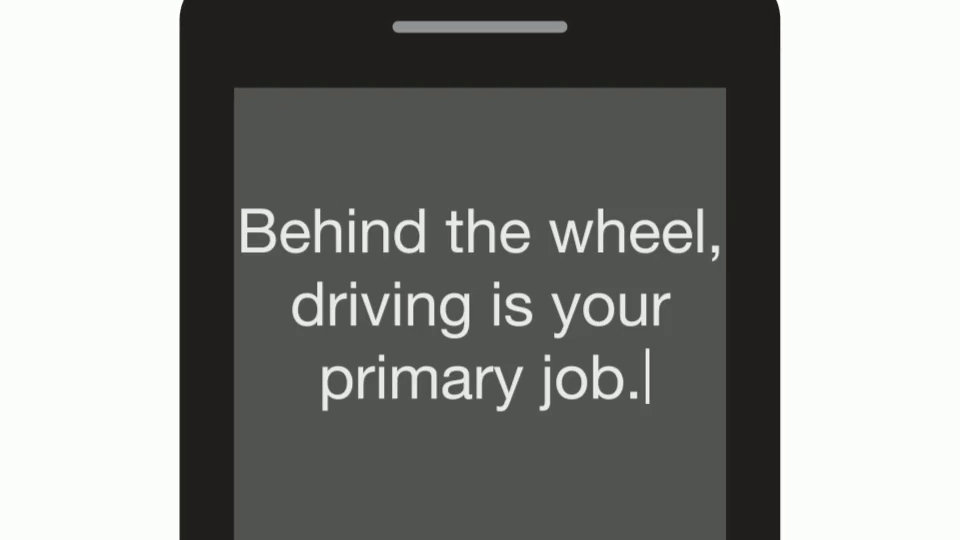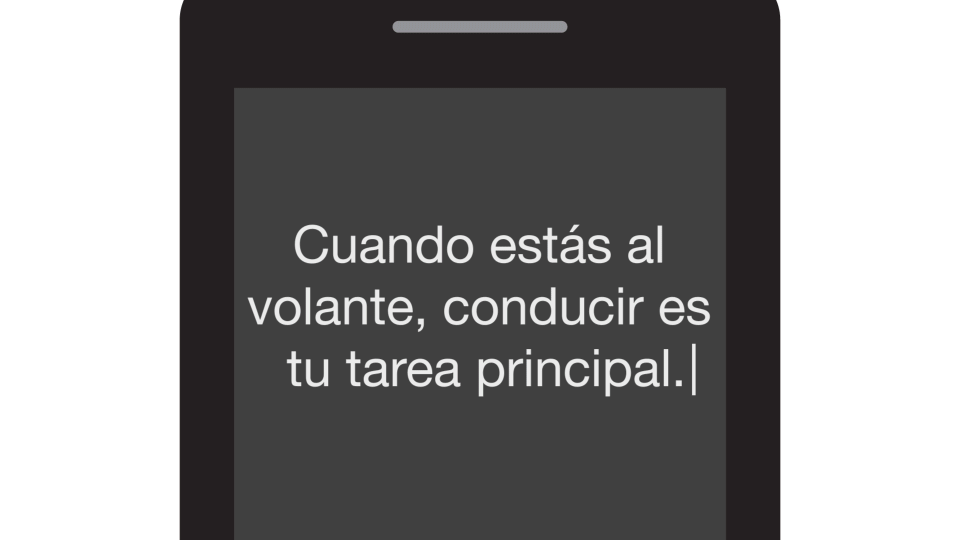MOTOR VEHICLE SAFETY AT WORK
Distracted Driving at Work

What is distracted driving at work?
Distracted driving occurs any time you take your eyes off the road, hands off the wheel, and mind off your primary task: driving safely. Any non-driving activity you engage in is a potential distraction and increases your risk of being involved in a motor vehicle crash.1
Workers in many industries and occupations spend part of their workdays on the road. One study showed drivers at work were more likely to be in a hurry to reach their destination, think about work, be tired, or use a cell phone.2
What are the main types of distractions?1
Visual, Manual, and Cognitive Distractions
Visual: Eyes off the road

- Reading a text message
- Looking up directions
- “Rubbernecking” (i.e., craning one’s neck to get a better view) at a crash site
Manual: Hands off the wheel

- Reaching for things inside the vehicle
- Using a hand-held device
- Adjusting the radio
- Eating or drinking
- Applying makeup
Cognitive: Mind off driving

- Talking on the phone
- Arguing with a passenger
- Thinking about your next appointment
Phones as Distractions
Why are phones so distracting?2
 Talking and texting on a phone are driving distractions. Texting while driving is especially dangerous because it combines all three types of distractions. Hands-free phones are not necessarily safer than hand-held devices. Your brain has limited ability to perform two tasks at the same time. When driving becomes secondary, you pay less attention to possible dangers on the road. A worker who is driving a motor vehicle while negotiating a complex or contentious business deal over the phone at the same time is at greater risk of being in a crash. In this situation, neither task – driving a vehicle or doing business – gets the attention it deserves.
Talking and texting on a phone are driving distractions. Texting while driving is especially dangerous because it combines all three types of distractions. Hands-free phones are not necessarily safer than hand-held devices. Your brain has limited ability to perform two tasks at the same time. When driving becomes secondary, you pay less attention to possible dangers on the road. A worker who is driving a motor vehicle while negotiating a complex or contentious business deal over the phone at the same time is at greater risk of being in a crash. In this situation, neither task – driving a vehicle or doing business – gets the attention it deserves.
What do we know about distracted driving?
Key Facts and Stats
- In 2014:4
- 16% of all motor vehicle crashes in the United States involved a distracted driver
- 431,000 people were injured in motor vehicle crashes involving a distracted driver
- 3,179 people died in crashes involving a distracted driver
- 520 non-occupants (e.g., pedestrians and cyclists) died in a crash that involved a distracted driver
- At any given time in 2015, an estimated 2.2% of all drivers on the road were texting or visibly using a hand-held device – the same percentage as in 2014.5
- Research suggests that distraction is present during 52% of normal driving. Common distractions are: interacting with an adult or teen passenger (15%), using a cell phone (6%), and using systems such as climate control and radio (4%).6
- On average, a non-fatal injury crash at work that involves distraction costs the employer $72,442.7
How can you prevent distracted driving at work?
Employers
Employers: Use the following recommendations to prevent distracted driving.8, 9
- Ban texting and hand-held phone use while driving a company vehicle, and apply the same rules to use of a company-issued phone while driving a personal vehicle.
- Consider banning the use of hands-free phones.
- Require workers to pull over in a safe location if they must text, make a call, or look up directions.
- Prepare workers before implementing these policies by communicating:
- How distracted driving puts them at risk of a crash
- That driving requires their full attention while they are on the road
- What they need to do to comply with your company’s policies
- What action you will take if they do not follow these policies
- Consider having workers acknowledge that they have read and understand these policies.
- Provide workers with information to help them talk to their family about distracted driving.
Resources for employers:
The Free Cell Phone Policy Kit
Download the National Safety Council’s kit for tips to help establish and implement a cell phone policy.
Distraction.gov
Get safety campaign materials as part of a distracted driving toolkit from the U.S. Department of Transportation and the Network of Employers for Traffic Safety.
Mobile phone use: a growing problem of driver distraction
Learn from the World Health Organization about current knowledge related to distractions caused by cell phone use while driving.
Workers
For workers: Take the following actions to stay focused behind the wheel.9
- Do not text or use a hand-held phone while driving. Further, avoid using hands-free phones as much as possible – even if your employer allows them.
- Pull over in a safe location if you must text or make a call.
- Make necessary adjustments (e.g., adjust controls, program directions) to your car before your drive.
- Do not reach to pick up items from the floor, open the glove box, or try to catch falling objects in the vehicle.
- Avoid emotional conversations with passengers, or pull over in a safe location to continue the conversation. For normal conversation, passengers in the vehicle can often help lower crash risk for adult drivers.
- Focus on the driving environment — the vehicles around you, pedestrians, cyclists, and objects or events that may mean you need to act quickly to control or stop your vehicle.
Resources for workers:
Distraction.gov
Learn how to understand distracted driving risks and how to talk with family and friends about the importance of staying focused while driving.
Distracted Driving: What You Can Do
Use the National Safety Council’s resources to spread the word about the dangers of distracted driving, learn about cell-phone blocking technology, and take a pledge to drive cell-free.
Distracted Driving
Explore the CDC National Center for Injury Prevention and Control (NCIPC) site for information and tools on distracted driving.
Parents Are the Key to Safe Teen Drivers
Download materials for parents to promote safe teen driving practices, including preventing distracted driving.
Federal and State Laws
Most U.S. states ban texting while driving, and a growing number also ban the use of hand-held devices. Get information on state laws.
Drivers of commercial motor vehicles (e.g., large trucks and buses) are not allowed to send or read texts while driving, or use a hand-held device while driving. Find information on commercial motor vehicle laws.
Sources
1National Highway Traffic Safety Administration [2013]. Visual-manual NHTSA driver distraction guidelines for in-vehicle electronic devices: notice of federal guidelines. Federal Register 78(81):24818-24890.
2Salminen S, Lähdeniemi E [2002]. Risk factors in work-related traffic. Transportation Research Part F 5(1):77-86.
3National Safety Council [2012]. Understanding the distracted brain. Why driving while using hands-free is risky behavior. Itasca, IL: National Safety Council. White Paper.
4National Highway Traffic Safety Administration [2016]. Distracted driving 2014. Washington, DC: National Highway Traffic Safety Administration.
5National Highway Traffic Safety Administration [2016]. Driver electronic device use in 2015. Washington, DC: National Highway Traffic Safety Administration.
6Dingus TA, Guo F, Lee S, Antin JF, Perez M, Buchanan-King M, Hankey J [2016]. Driver crash risk factors and prevalence evaluation using naturalistic driving data. Proceedings of the National Academy of Sciences 113(10):2636-2641.
7Network of Employers for Traffic Safety [2015]. Cost of crashes – 2015. Vienna, VA: NETS.
8NIOSH [2015]. Preventing work-related motor vehicle crashes. By Pratt SG, Rodríguez-Acosta RL. Morgantown, WV: US Department of Health and Human Services, Centers for Disease Control and Prevention, National Institute for Occupational Safety and Health, DHHS (NIOSH) Publication No. 2015-111.
9National Safety Council [2011]. Cell phone policy kit [downloadable].
- Page last reviewed: May 1, 2017
- Page last updated: July 20, 2017
- Content source:
- National Institute for Occupational Safety and Health Division of Safety Research


 ShareCompartir
ShareCompartir

